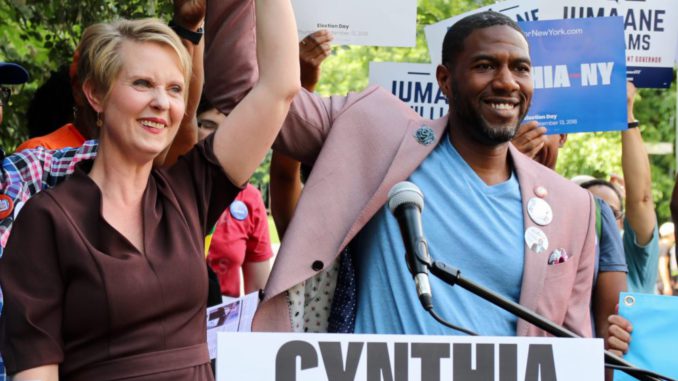
By Rebecca C
Following the final vote by the CLC to endorse the candidacies of Cynthia Nixon and Jumaane Williams on July 29, the strategy laid out by the CLC and distributed in this document was to focus field work in SD 18, Julia Salazar’s district. The the main goal was to avoid diverting resources from ongoing operations while drawing attention to working groups’ campaigns. Secondary goals were to build coalitions with other progressive interest groups, and to raise the profile of NYC-DSA.
To this end, multiple joint canvasseswere held in August and early September. In Central Brooklyn, Uptown/Bronx, and Queens the joint canvassing with the Nixon campaign focused on housing, in South Brooklyn on the New York Health Act (NYHA), and in Lower Manhattan on both housing and NYHA. NYC-DSA Disability Caucus held a disability justice virtual town hall with Nixon on Aug. 21. Outside of Senate District 18 there were around 100 canvassing shifts which identified around 375 Cynthia Nixon supporters.
Most of the Central Brooklyn canvassing events focused on educating and persuading residents as opposed to vote-counting. Tom R of CBK noted that the issue of the housing crisis was particularly resonant in the Crown Heights canvasses, and that most of the canvassers’ interactions were with people who were not aware of the universal rent control campaign, nor of DSA and Cynthia Nixon. Jumaane Williams enjoyed more name recognition. He came away with a positive view, regardless of the electoral outcome, saying “I’m generally enthusiastic about issue-based canvassing, because it feels less transactional; you’re educating and engaging people more than anything else. My ultimate takeaway is that anytime we can go talk to our neighbors, it’s worthwhile.”
Chi A and Noah W, SBK OC members and canvass coordinators, found that during NYHA/Nixon-Williams canvassing in Park Slope, while people were aware of DSA and even approached canvassers unsolicited to talk about DSA in general, “awareness of the [NYHA] bill is incredibly low and proves the need for our organizing work around this issue because few media outlets and relatively few NY political leaders are helping to get the word out.” Chi knew from past experience canvassing that healthcare is a major pain point for many people. “Everyone is frustrated with their health insurance and the rising costs, and when I informed the folks I canvassed that New York State plans to raise health insurance premiums yet again in 2019, they were angrily shocked. I do think that as was the case with other shortcomings in Cuomo’s platform and tenure as governor, Nixon’s campaign helped to raise awareness of the opportunity to achieve universal healthcare in New York and how Cuomo has dropped the ball here by empowering the IDC for so long.” Chi observed that even Cuomo’s supporters often seemed to express misgivings about him.
Another stated aim of the NYC-DSA strategy in getting involved with electoral campaigning was to encourage candidates to shift leftward and adopt socialist positions on important issues. Zelig S, Labor Branch representative to the SC, points out the profound effect of DSA’s involvement in shaping Nixon’s platform on labor issues: “At the time NYC-DSA endorsed Nixon, her campaign had almost no platform around issues of labor. As part of our Chapter’s endorsement, we recommended that the campaign meet with our Labor Branch to discuss the drafting of a Labor Platform. At the meeting, which was attended by members of the Labor Branch Organizing Committee, Nixon and her campaign enthusiastically committed to adopting every item of the proposed platform we put forward, including the right of public sector workers to strike. This turned out to be a critical issue which allowed the campaign to differentiate itself from Cuomo’s cynical, and paper thin, support for left wing causes.”
Coming out of the race, NYC-DSA certainly has higher name-recognition among voters. What can be done with this in our struggle for an equitable New York remains to be seen.
